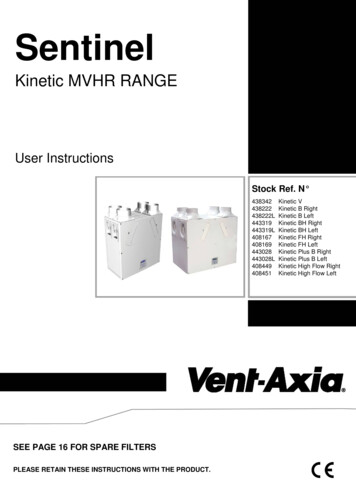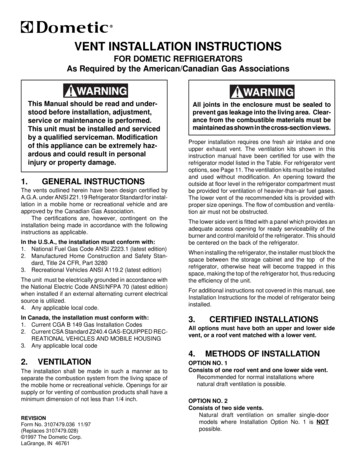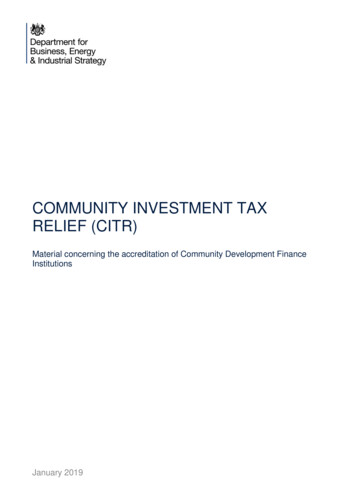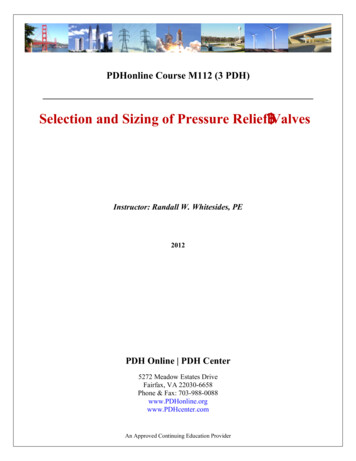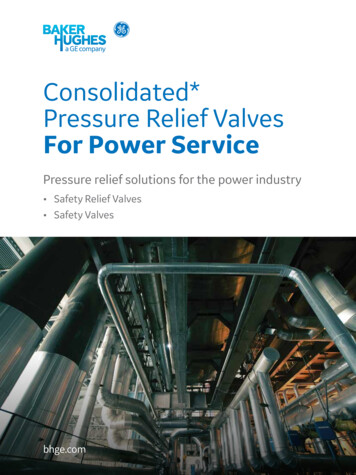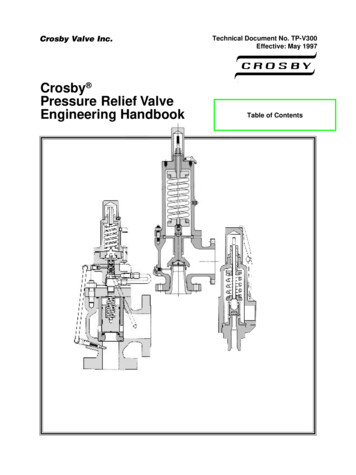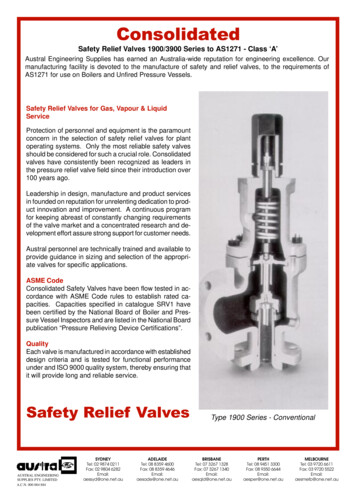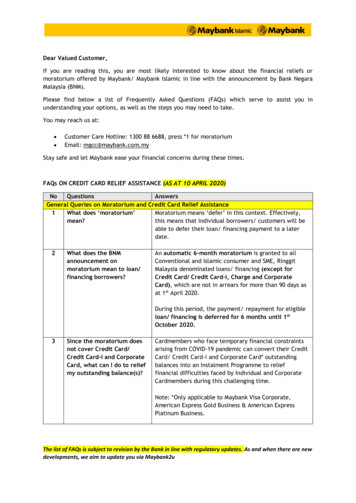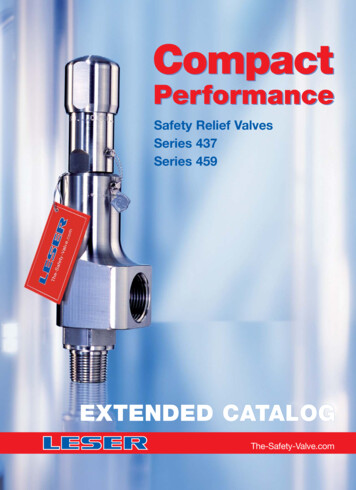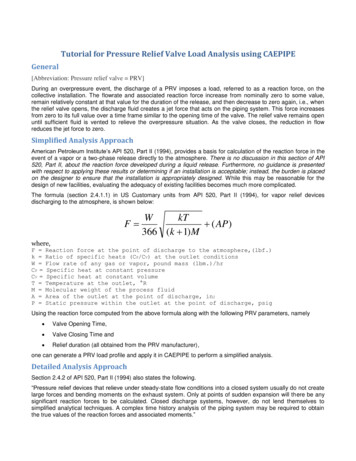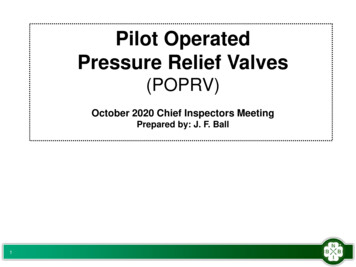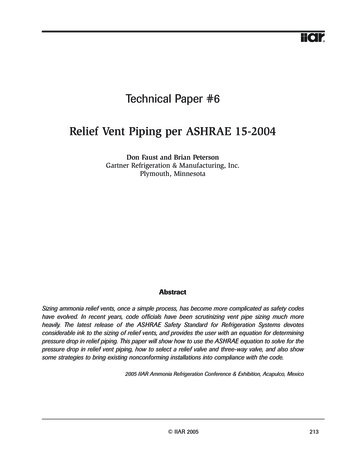
Transcription
Technical Paper #6Relief Vent Piping per ASHRAE 15-2004Don Faust and Brian PetersonGartner Refrigeration & Manufacturing, Inc.Plymouth, MinnesotaAbstractSizing ammonia relief vents, once a simple process, has become more complicated as safety codeshave evolved. In recent years, code officials have been scrutinizing vent pipe sizing much moreheavily. The latest release of the ASHRAE Safety Standard for Refrigeration Systems devotesconsiderable ink to the sizing of relief vents, and provides the user with an equation for determiningpressure drop in relief piping. This paper will show how to use the ASHRAE equation to solve for thepressure drop in relief vent piping, how to select a relief valve and three-way valve, and also showsome strategies to bring existing nonconforming installations into compliance with the code.2005 IIAR Ammonia Refrigeration Conference & Exhibition, Acapulco, Mexico IIAR 2005213
ACKNOWLEDGEMENTThe success of the technical program of the 27th Annual Meeting of theInternational Institute of Ammonia Refrigeration is due to the quality of the technicalpapers in this volume. IIAR expresses its deep appreciation to the authors,reviewers, and editors for their contributions to the ammonia refrigeration industry.Board of Directors, International Institute of Ammonia RefrigerationABOUT THIS VOLUMEIIAR Technical Papers are subjected to rigorous technical peer review.The views expressed in the papers in this volume are those of the authors, not theInternational Institute of Ammonia Refrigeration. They are not official positions ofthe Institute and are not officially endorsed.EDITORSM. Kent Anderson, PresidentChris Combs, Project CoordinatorGene Troy, P.E., Technical DirectorInternational Institute of Ammonia Refrigeration1110 North Glebe RoadSuite 250Arlington, VA 22201 1-703-312-4200 (voice) 1-703-312-0065 (fax)www.iiar.org2005 Ammonia Refrigeration Conference & ExhibitionFairmont Acapulco PrincessAcapulco, Mexico
Relief Vent Piping per ASHRAE 15-2004 — Don Faust and Brian PetersonIntroductionBack in the old days, sizing ammonia relief vents was a simple process. Designerswould calculate the outlet area of each relief valve in the system and make sure thatthe relief header had at least that much area, and that was the end of it. Nocomplicated equations, no computerized solutions. However, the codes have evolved,and much more scrutiny has been given to the sizing of relief vents in recent years.The latest release of ASHRAE Safety Standard for Refrigeration Systems, ASHRAE 15,devotes considerable ink to the sizing of relief vents, and provides the user with anequation for determining pressure drop in relief piping. (ASHRAE, 2004) This papershows how to use the ASHRAE equation to solve for the pressure drop in relief ventpiping, how to select a relief valve and three-way valve, and some strategies to bringexisting nonconforming installations into compliance with the code.There are three steps to sizing a relief vent system:1. Determine the required capacity of relief valve for each piece of equipment2. Select relief valves and three-way valves and determine the actual capacity of thevalves selected3. Size the relief vent piping systemIn this paper, steps 2 and 3 above are assisted by a design tool, SRVQuick, which isfreeware, a beta version of which is available through the IIAR website.Step 1: Determine Required CapacityThroughout this paper, three different relief valve capacities will be discussed. Forclarity, they are defined as follows: Required Capacity: the calculated amount needed to protect the device. Rated Capacity: the capacity of the relief valve with no restrictions (i.e., thecapacity of the valve as read directly from the manufacturer’s charts).Technical Paper #6 IIAR 2005215
2005 IIAR Ammonia Refrigeration Conference & Exhibition, Acapulco, Mexico Adjusted Capacity: the capacity of the relief valve after accounting for inletrestrictions.Where are relief valves required?ASHRAE 15 states that an approved pressure relief device must protect the followingdevices: All pressure vessels subject to the ASME Boiler and Pressure Vessel Code (vesselsless than 6″ [152 mm] in diameter may use a fusible plug) Shell and tube evaporators Shell and tube condensers Positive displacement compressors (if equipped with a stop valve on thedischarge) Certain evaporators, if located near a heating coilLocal codes also may require relief valves on other pieces of equipment (i.e.,evaporative condensers).Pressure Vessels and Heat ExchangersThe required relief capacity is calculated according to the formula:C fDL(1)where:C minimum required discharge capacity of the relief valve, lbs.air/min [kg/s]f constant, based upon the refrigerant. For ammonia, f 0.5[f 0.041]D diameter of the vessel, ft [m]L length of the vessel, ft [m]216 IIAR 2005Technical Paper #6
Relief Vent Piping per ASHRAE 15-2004 — Don Faust and Brian PetersonAs a reference to the designer, Table 1 contains values of f for several refrigerants.Additionally, ASHRAE 15 specifies that when combustible materials are used within20 feet [6.1 m] of a pressure vessel, then the value of f must be multiplied by 2.5.This has lead to some concern because engine rooms are often used to storerefrigerants, refrigerant oils, and even flammable fuels. OSHA makes a distinctionbetween flammable and combustible. Most refrigerants, oils and even fuels are notclassified as combustible, and thus the 2.5 factor does not apply. Refer to OSHA’sregulations for a complete description and classification of combustible andflammable materials. (OSHA, 1996) It is interesting to note that if a receiver werelocated above a tar roof, then the 2.5 factor would apply. Wood and paper would beconsidered to be combustible solids as well.Example Vessel CalculationFind the required relief capacity for a 42 [1.07 m] diameter, ASME vessel,12 ft [3.66 m] in length, containing ammonia refrigerant.Equation 1 applies in this situation:C fDLC (0.5) (3.5) (12)[C (0.041) (1.07) (3.66)]C 21 lbs. air/min[0.16 kg/s]Note: To convert lbs. air/min [kg/s] to standard cubic feet per minute (SCFM) [l/s],multiply by 13.1 ft3/lb [816 l/kg] (assuming dry air at 60 F [16 C]). Thus, for theabove example:C (21) (13.1)[C (0.16) (816)]C 275.1 SCFM[C 130 l/s]Technical Paper #6 IIAR 2005217
2005 IIAR Ammonia Refrigeration Conference & Exhibition, Acapulco, MexicoPositive Displacement CompressorsSection 3 of ASHRAE 15 defines a positive displacement compressor as one “inwhich the increase in pressure is attained by changing the internal volume of thecompression chamber.” Screw compressors and reciprocating compressors both fallinto this category. When such a compressor is equipped with a stop valve on thedischarge line, as most industrial refrigeration compressors are, a relief device mustprotect it.Section 9.8 of ASHRAE 15 separately addresses compressors that meet, and thosethat do not meet, all of the following criteria: Must be equipped with capacity regulation Can regulate capacity to minimum flow at discharge pressures equal to 90% ofthe pressure relief setting Must be equipped with a pressure-limiting device installed and set per Section 9.9.If the compressor cannot regulate flow per the standard, then the relief valve mustbe sized for the full flow of the compressor. If the compressor does meet the criteria,then the required capacity is the minimum flow of the compressor. In either case,the compressor flow is calculated based upon the following conditions: High Stage: Flow is based upon 50 F [10 C] saturated suction at the compressor Booster: Flow is based upon saturated suction equal to the design operatingintermediate temperature.For swing compressors, which can operate either as a booster or a high stagecompressor, the relief valve should be sized for the worst case. This would typicallybe the high stage rating.Appendix F of ASHRAE 15 shows an approved method of calculating the dischargecapacity of a positive displacement compressor, and the reader is referred to thatdocument for calculations from scratch. The authors requested data from all218 IIAR 2005Technical Paper #6
Relief Vent Piping per ASHRAE 15-2004 — Don Faust and Brian Petersoncompressor manufacturers showing the required relief capacity from each of theirmodels of compressors. Data from the manufacturers who responded are shown inTables 2a through 2d.Step 2: Selecting Relief Valves and Determining their CapacityA look-up table is provided that lists the commonly used relief valves and theirratings in lbs. air/min [kg/s]. (Table 3) Selecting a relief valve could be as simple asfinding one in the table with at least as much capacity as is required. However, thedesigner and owner should be aware that inlet and outlet restrictions could have asignificant effect on the actual capacity of the relief device. There are certaincombinations of relief valves and three-way valves that can reduce the rated capacityof the relief valve by as much as 40%.Calculating Inlet RestrictionsThe capacity of any relief valve is reduced by the losses in the piping and valvesbetween the relief device and the equipment it protects. ASHRAE provides a methodof calculating the reduction in relief valve capacity imposed by inlet restrictions.Calculating inlet restrictions is important for two reasons: It assures that the relief valve selected actually has the required capacity. Code allows the designer to use the adjusted (reduced) capacity of the reliefvalve to size the relief vent.There are three components of inlet losses to the relief valve: Entrance losses at the nozzle of the vessel Pipe and fitting losses in the piping to the three-way valve Losses in the three-way valveTechnical Paper #6 IIAR 2005219
2005 IIAR Ammonia Refrigeration Conference & Exhibition, Acapulco, MexicoTwo methods are commonly used to evaluate inlet restrictions. One uses k, aresistance factor, and the other uses Cv, a flow coefficient. This paper illustrates howto solve for inlet restrictions using Cv. Table 4 shows Cv values for flow restrictionscommonly found on inlets.Using Cv to Find the Effect of Inlet Restrictions: The overall equation for adjusting Cvfor a series of flow restrictions is:1C2v0 (2)111C2v1 C2v2 C2v3 .where:Cv0 adjusted system flow coefficientCv1,2,3 flow coefficients for a series of pipes and valvesWith the above equation, if we know the Cv of every item in the piping leading upto and including the relief valve, we can calculate the overall flow coefficient.To assist with this, Table 5 lists flow coefficients for piping common to relief inlets,and Table 6 lists the flow coefficients of many of the three-way valves in current use.Note that most three-way valves have different flow coefficients for the two differentsides. This is because of the shaft that runs through one side and not the other. Thetable lists the flow coefficient for the worst-case side of the three-way valve.For the relief valve, Cv is determined by Equation (13) in the Users Manual forANSI/ASHRAE 15-2001, Appendix H (ASHRAE, 2003):Cv 22022.53 CrP1 IIAR 2005(3)Technical Paper #6
Relief Vent Piping per ASHRAE 15-2004 — Don Faust and Brian Petersonwhere:Cv Cr P1 [P1 flow coefficient for the relief valverated valve capacity, lbs. air/min [kg/s]valve set pressure (psig) *1.1 atmospheric pressurevalve set pressure (barg)*1.1 1 bar]When you know the adjusted system flow coefficient, Cv0, the adjusted flow, Ca,through the relief valve assembly can be calculated using the following equation:Ca Cr (Cv0/Cv)(4)where:Ca Cr Cv Cv0 adjusted system flowrelief valve rated flowrelief valve flow coefficient determined by Equation 3adjusted system flow coefficient calculated in Equation 2Example Inlet Restriction CalculationDetermine the actual capacity of a 250-psig [17.0-barg] relief valve (Henry 5601,1 2 ″ x 1 3 ″[13 mm x 19 mm]) with a 1 2 ″ [13 mm] three-way valve (Henry 8021A),connected to a 1 2 ″ [13 mm] nozzle on a vessel.From Table 3, at 250 psig [17.0 barg], this model has a capacity of 57.6 lbs.air/min [0.436 kg/s].Cr 57.6 lbs. air/min [0.436 kg/s]Technical Paper #6 IIAR 2005221
2005 IIAR Ammonia Refrigeration Conference & Exhibition, Acapulco, MexicoFrom Equation 3 the Cv for the relief valve is:Cv 22.53 (57.6) / (250*1.1 14.7)Cv 4.48From Table 4, the 1 2 ″ nozzle has a Cv of 12.6.From Table 6, the Henry 8021A three-way valve has a Cv of 5.34.Using these values, we apply Equation 2:1C2v0 111 4.48212.625.342C2v0 10.96Cv0 3.31The adjusted capacity of the valve is found by applying Equation 4:Ca Cr(Cv0/Cv)Ca (57.6) (3.31/4.48)Ca 42.6 lbs. air/min [0.322 kg/s]In this example, the relief valve lost roughly 25% of its capacity due to inletlosses.222 IIAR 2005Technical Paper #6
Relief Vent Piping per ASHRAE 15-2004 — Don Faust and Brian PetersonUse of Rupture Discs on Relief Valve InletsNotably, ASHRAE 15 does not address reducing the capacity of the relief valve whenrupture discs are installed in series with them. Some installations include a rupturedisc between the three-way valve and the relief valve along with a non-resettingpressure gauge. This is useful in helping to determine which relief valve lifted in alarge system. When this arrangement is employed, the capacity of the relief valve isto be reduced to 90% of its rated capacity. It is ASME Boiler and Pressure VesselCode that dictates this, not ASHRAE 15. (ASME, 2004)To quote the ASME Code, Section VIII – Division 1, Part UG-127: NonreclosingPressure Relief Devices:(3) Application of Rupture disks(b 2) The marked capacity of a pressure relief valve (nozzle type) wheninstalled with a rupture disk device between the inlet of the valve and thevessel shall be multiplied by a factor of 0.90 of the rated relieving capacity ofthe valve alone Step 3. Sizing the Relief Vent Piping SystemAppendix H of ASHRAE 15 lists the formula to use when figuring o
Sizing ammonia relief vents, once a simple process, has become more complicated as safety codes have evolved. In recent years, code officials have been scrutinizing vent pipe sizing much more heavily. The latest release of the ASHRAE Safety Standard for Refrigeration Systems devotes considerable ink to the sizing of relief vents, and provides the user with an equation for determining pressure .
